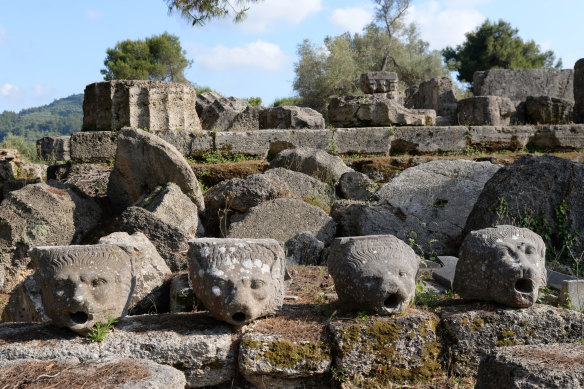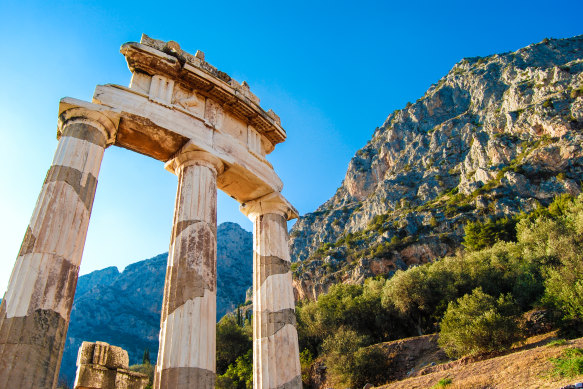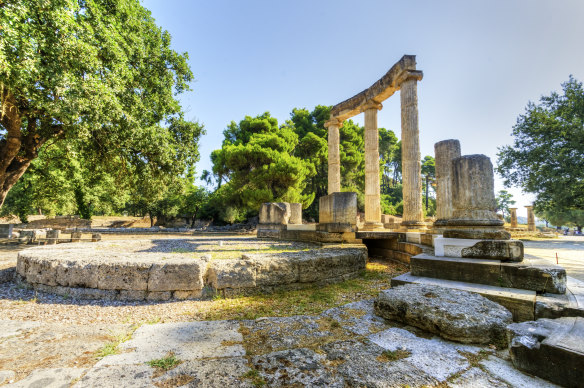The seven wonders of Ancient Olympia, Greece
In the lead-up to the Olympic Games, take a look at where it all began.
Archaeological Site of Olympia (Ancient Olympia)

Olympia was the birthplace of the most famous and important sporting event in the ancient world. The site was dedicated to Zeus.Credit: Getty Images
Considered the most important of all the competitions between the city states, this is where the Olympic Games took place every four years for 12 centuries. The site was both a games venue and a religious sanctuary dedicated to Zeus. Get there early, or in the late afternoon when it’s largely free of crowds. Meander through the ruins and the flowering pink Judas trees and rev up your imagination (or download the QR code that handily recreates the site in 3-D).
Be amazed by the “statue” and Temple of Zeus
One of the official seven ancient wonders of the world, the massive 12 metre or so statue of Zeus, made by Greek sculptor Phideas around 435 BC, no longer exists. But you can visualise it in its original spot: a Doric temple that was Ancient Olympia’s most important locale and the hallowed stop for visitors to the sanctuary. When the sun reflected off the cistern of olive oil (strategically located in front of the temple), the statue’s jewels – gold, ivory, diamonds, rubies and sapphires – sparkled and shimmered, amazing the crowds.
Spend time in the Archaeological Museum of Olympia

The site was both a games venue and a religious sanctuary dedicated to Zeus.
Ponder over the superb exhibits, from votive offerings such as small figurines and terracotta pots, along with exquisite signet rings, chains and oil lamps that help you envisage human activity. Other fascinating objects are the statues of victors that stood atop columns, tripods and detailed mosaic floors. You can even circle around the fourth-century Parian marble statue of Hermes carrying baby Dionysus, carved by Praxiteles, and Nike, the goddess of victory, by Paionios.
Aim for the Pediments
If you’ve time for only one thing in the Archaeological Museum, head to Hall 5 and view the two pediments that adorned the Temple of Zeus. These are the “movies” of ancient times, according to Guide Nicki Vlachou (see below). The West Pediment, depicting a frenzied skirmish between Lapiths and Centaurs, is a riot of action. The striking figure in the middle, Apollo, with his arm outstretched, is calling for calm, or so it’s said. The East Pediment portrays the mythical chariot race between Oinomaos and Pelops, after which the Peloponnese region is named.
Sprint to the Stadium

Running at Olympia, birthplace of the Olympic Games. Credit: iStock
Aim to get there on opening and dash to the stadium. It’s goosebump-inducing stuff; feel the panting breath of Coroebus, a champion runner from Ancient Elis, as he runs by, his nude body smothered in olive oil, as was the norm. More than 45,000 spectators gathered here to watch the competitions, some of which included foot races, long jump, discus and javelin, plus boxing and wrestling (and the pankration, a violent combination of both). Feeling fit? Sprint the 192.3 metres, considered more or less an ancient “stade” or “600 feet of Hercules”; the original start and finish line are still in place. It’s here that the Olympic flame starts its relay journey to the host country.
Employ a guide

Ruins of the ancient site of Olympia.Credit: iStock
Do the site justice: take a tour with Niki Vlachou (Niki Olympic Tours; olympictours.gr). She evokes the aroma of the athletes’ sweat as you journey back millennia, covering everything from the Olympic ideals (to put a temporary stop to wars), to the treasury buildings (built by rich city states), to the victors’ prizes (food for life and an olive wreath).
Head to the Museum of the History of the Ancient Olympic Games
Stroll through this lovely Neoclassical building for context to both the Olympic Games and the other Panhellenic Games – Pythia (Delphi), Nemea and Isthmia (yes, there was a series of Games). Don’t miss the fabulous exhibits revealing the role of females; the high priestess aside, married women weren’t permitted into the stadium.
The writer travelled at her own expense.
Sign up for the Traveller Deals newsletter
Get exclusive travel deals delivered straight to your inbox. Sign up now.